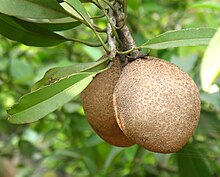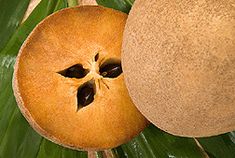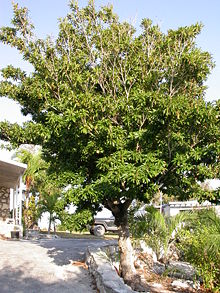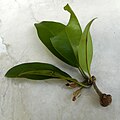bio.wikisort.org - Plant
Manilkara zapota, commonly known as sapodilla ([ˌsapoˈðiʝa]),[2] sapote, naseberry, nispero or chicle,[3] is a long-lived, evergreen tree native to southern Mexico, Central America and the Caribbean. An example natural occurrence is in coastal Yucatán in the Petenes mangroves ecoregion, where it is a subdominant plant species.[4] It was introduced to the Philippines during Spanish colonization. It is grown in large quantities in Mexico and in tropical Asia including India, Pakistan, Thailand, Malaysia, Cambodia, Indonesia, Vietnam, Bangladesh.
| Manilkara zapota | |
|---|---|
 | |
Conservation status | |
| Scientific classification | |
| Kingdom: | Plantae |
| Clade: | Tracheophytes |
| Clade: | Angiosperms |
| Clade: | Eudicots |
| Clade: | Asterids |
| Order: | Ericales |
| Family: | Sapotaceae |
| Genus: | Manilkara |
| Species: | M. zapota |
| Binomial name | |
| Manilkara zapota (L.) P.Royen | |
| Synonyms | |
 Fruit, cross-section | |
| Nutritional value per 100 g (3.5 oz) | |
|---|---|
| Energy | 347 kJ (83 kcal) |
Carbohydrates | 19.96 g |
| Dietary fiber | 5.3 g |
Fat | 1.1 g |
Protein | 0.44 g |
| Vitamins | Quantity %DV† |
| Riboflavin (B2) | 2% 0.02 mg |
| Niacin (B3) | 1% 0.2 mg |
| Pantothenic acid (B5) | 5% 0.252 mg |
| Vitamin B6 | 3% 0.037 mg |
| Folate (B9) | 4% 14 μg |
| Vitamin C | 18% 14.7 mg |
| Minerals | Quantity %DV† |
| Calcium | 2% 21 mg |
| Iron | 6% 0.8 mg |
| Magnesium | 3% 12 mg |
| Phosphorus | 2% 12 mg |
| Potassium | 4% 193 mg |
| Sodium | 1% 12 mg |
| Zinc | 1% 0.1 mg |
| |
| †Percentages are roughly approximated using US recommendations for adults. Source: USDA FoodData Central | |
The specific epithet zapota is from the Spanish zapote [saˈpote], which ultimately derives from the Nahuatl word tzapotl.
Description

Sapodilla can grow to more than 30 m (98 ft) tall with a trunk diameter of up to 1.5 m (5 ft). The average height of cultivated specimens, however, is usually between 9 and 15 m (30 and 49 ft) with a trunk diameter not exceeding 50 cm (20 in).[5] It is wind-resistant and the bark is rich in a white, gummy latex called chicle. The ornamental leaves are medium green and glossy. They are alternate, elliptic to ovate, 7–15 cm (3–6 in) long, with an entire margin. The white flowers are inconspicuous and bell-like, with a six-lobed corolla. An unripe fruit has a firm outer skin and when picked, releases white chicle from its stem. A fully ripened fruit has saggy skin and does not release chicle when picked.
The fruit is a large berry, 4–8 cm (2–3 in) in diameter.[6][7] Inside, its flesh ranges from a pale yellow to an earthy brown color with a grainy texture akin to that of a well-ripened pear. Each fruit contains one to six seeds.[7] The seeds are hard, glossy, and black, resembling beans, with a hook at one end that can catch in the throat if swallowed.
The fruit has an exceptionally sweet, malty flavor. The unripe fruit is hard to the touch and contains high amounts of saponin, which has astringent properties similar to tannin, drying out the mouth.
The trees can survive only in warm, typically tropical environments, dying easily if the temperature drops below freezing. From germination, the sapodilla tree will usually take anywhere from five to eight years to bear fruit. The sapodilla trees yield fruit twice a year, though flowering may continue year round.[8]
Other names

Other common names in English for Manilkara zapota include bully tree, sawo, marmalade palm and chiku.[9]
Biological studies
Compounds extracted from the leaves showed anti-diabetic, antioxidant and hypocholesterolemic (cholesterol-lowering) effects in rats.[10]
Acetone extracts of the seeds exhibited in vitro antibacterial effects against strains of Pseudomonas oleovorans and Vibrio cholerae.[11]
Synonyms
Synonyms of this species include:[12]
- Achradelpha mammosa (L.) O.F.Cook
- Achras breviloba (Gilly) Lundell
- Achras calderonii (Gilly) Lundell
- Achras conzattii (Gilly) Lundell
- Achras coriacea Lundell
- Achras dactylina Lundell
- Achras gaumeri (Gilly) Lundell
- Achras latiloba Lundell
- Achras lobulata (Lundell) Lundell
- Achras lucuma Blanco
- Achras mammosa L. nom. illeg.
- Achras meridionalis (Gilly) Lundell
- Achras occidentalis Cels ex Ten.
- Achras paludosa Lundell
- Achras petenensis (Lundell) Lundell
- Achras rojasii (Gilly) Lundell
- Achras sapatilla J.Paul & W.Arnold
- Achras sapota L. [Spelling variant]
- Achras striata (Gilly) Lundell
- Achras tabogaensis (Gilly) Lundell
- Achras tainteriana Lundell
- Achras tchicomame Perr.
- Achras verrucosa Stokes
- Achras zapota L.
- Achras zapotilla (Jacq.) Nutt.
- Calocarpum mammosum (L.) Pierre
- Calospermum mammosum (L.) Pierre
- Gambeya mammosa (L.) Pierre
- Lucuma mammosa (L.) C.F.Gaertn.
- Lucuma zapota (L.) Urb.
- Manilkara achras (Mill.) Fosberg
- Manilkara breviloba Gilly
- Manilkara calderonii Gilly
- Manilkara conzattii Gilly
- Manilkara gaumeri Gilly
- Manilkara grisebachii (Pierre) Dubard
- Manilkara meridionalis Gilly
- Manilkara rojasii Gilly
- Manilkara striata Gilly
- Manilkara tabogaensis Gilly
- Manilkara zapotilla (Jacq.) Gilly
- Manilkariopsis lobulata Lundell
- Manilkariopsis meridionalis (Gilly) Lundell
- Manilkariopsis petenensis Lundell
- Manilkariopsis rojasii (Gilly) Lundell
- Manilkariopsis striata (Gilly) Lundell
- Manilkariopsis tabogaensis (Gilly) Lundell
- Mimusops grisebachii Pierre
- Nispero achras (Mill.) Aubrév.
- Pouteria mammosa (L.) Cronquist
- Sapota achras Mill.
- Sapota zapotilla (Jacq.) Coville ex Safford
- Vitellaria mammosa (L.) Radlk.
Uses
The fruit is edible and a favorite in the tropical Americas.[13] Chicle from the bark is used to make chewing gum.
See also
References
- Martínez Salas, E.; Samain, M. & Oldfield, S. (2021). "Manilkara zapota". IUCN Red List of Threatened Species. 2021: e.T61964429A61964470. Retrieved 23 June 2022.
- USDA, NRCS (n.d.). "Manilkara zapota". The PLANTS Database (plants.usda.gov). Greensboro, North Carolina: National Plant Data Team. Retrieved 23 June 2022.
- "Manilkara zapota". Germplasm Resources Information Network (GRIN). Agricultural Research Service (ARS), United States Department of Agriculture (USDA). Retrieved 23 June 2022.
- World Wildlife Fund. eds. Mark McGinley, C.Michael Hogan & C. Cleveland. 2010. Petenes mangroves. Encyclopedia of Earth. National Council for Science and the Environment. Washington DC Archived 2011-10-15 at the Wayback Machine
- Manilkara zapota Sapotaceae (L.) van Royen, Orwa C, Mutua A, Kindt R, Jamnadass R, Simons A. 2009. Agroforestree Database:a tree reference and selection guide version 4.0 (http://www.worldagroforestry.org/af/treedb/)
- Flora of North America, vol. 8
- Harris, Kate (2009). Trees of Belize. Belize: Bay Cedar Publishing. pp. 94–95. ISBN 9780992758202.
- Kute, L.S.; Shete, M.B. (1995). "Sapota (Sapodilla)". Handbook of Fruit Science and Technology. CRC Press. pp. 475–476. Retrieved 24 August 2022.
- "Manilkara zapota". European and Mediterranean Plant Protection Organization (EPPO). Retrieved 23 June 2022.
- Fayek NM, Monem AR, Mossa MY, Meselhy MR, Shazly AH (2012). "Chemical and biological study of Manilkara zapota (L.) Van Royen leaves (Sapotaceae) cultivated in Egypt". Pharmacognosy Research. 4 (2): 85–91. doi:10.4103/0974-8490.94723. PMC 3326762. PMID 22518080.
- Kothari V, Seshadri S (2010). "In vitro antibacterial activity in seed extracts of Manilkara zapota, Anona squamosa, and Tamarindus indica". Biol. Res. 43 (2): 165–8. doi:10.4067/S0716-97602010000200003. PMID 21031260.
- The Plant List: A Working List of All Plant Species, retrieved 18 October 2015
- Hargreaves, Dorothy; Hargreaves, Bob (1964). Tropical Trees of Hawaii. Kailua, Hawaii: Hargreaves. p. 14.
External links
На других языках
[de] Breiapfelbaum
Der Breiapfelbaum (Manilkara zapota), auch Sapote, Chicozapote, Nispero, Sicte, Mamey, Kaugummibaum oder Sapotillbaum genannt, ist eine Pflanzenart aus der Familie der Sapotengewächse (Sapotaceae). Diese Art ist wirtschaftlich von Bedeutung, da ihr Milchsaft für die Gewinnung von Naturgummi genutzt wird. Der Chicle genannte Rohstoff wird unter anderem zur Herstellung von Kaugummi verwendet. Auch die Sapodilla genannten Früchte sind von Bedeutung, sie werden als Obst gegessen.- [en] Manilkara zapota
[es] Manilkara zapota
El chicle o chicozapote (Manilkara zapota) es un árbol de la familia de las sapotáceas (antes llamado Sapota zapotilla, chicozapote o Achras zapota) originario de América Central y América del Sur tropical. También es conocido coloquialmente como ácana o níspero. Fue introducido en Filipinas durante la colonización española. A partir de entonces, se extendió por Asia y crece en grandes cantidades en India, Tailandia, Malasia, Camboya, Indonesia o Bangladés, lugares donde el fruto es muy popular y se conoce como chikoo. La palabra zapote es de origen náhuatl: tzapotl, nombre que se les daba a los frutos de forma esférica y semillas grandes. La palabra chicle también es de origen náhuatl chictli/tzictli. En maya es sicte, árbol sagrado del chicozapote.[3] Por su sabor dulce y aromático, numerosos pueblos amerindios utilizaban la goma para mascar, conocida como chicle (del náhuatl tzictli[4]) que es un polímero gomoso que se obtiene de la savia del árbol. En otras partes de Iberoamérica y en España es sinónimo de goma de mascar; si bien la mayoría de las actuales emplean una base de plástico neutro, el acetato polivinílico. Hasta hace relativamente poco tiempo el chicle utilizaba aún esta savia como material. Un sustituto del chicle también se puede obtener de la piel de vacuno.[ru] Саподилла
Саподи́лла, сапоти́лла[1]:159, чи́ку, сапоти́ловое де́рево, ма́сляное дерево, а́хра (лат. Manilkara zapóta) — плодовое дерево семейства Сапотовые.Другой контент может иметь иную лицензию. Перед использованием материалов сайта WikiSort.org внимательно изучите правила лицензирования конкретных элементов наполнения сайта.
WikiSort.org - проект по пересортировке и дополнению контента Википедии






